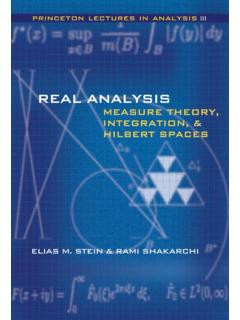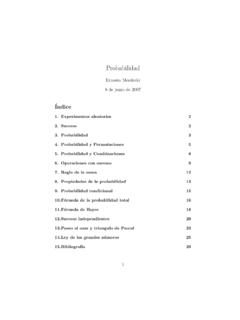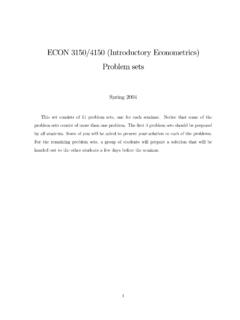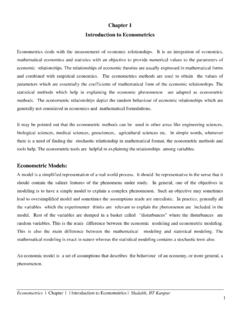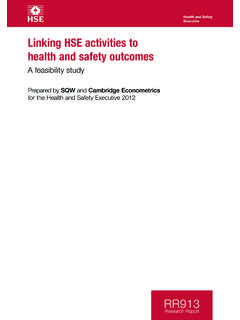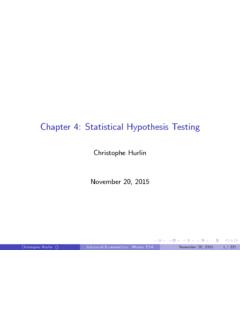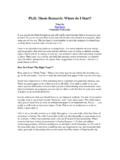Transcription of GARCH 101: The Use of ARCH/GARCH Models in …
1 GARCH 101: The Use ofARCH/ GARCH Models in AppliedEconometricsRobert EngleThe great workhorse of applied econometrics is the least squares is a natural choice, because applied econometricians are typicallycalled upon to determine how much one variable will change in responseto a change in some other variable. Increasingly however, econometricians arebeing asked to forecast and analyze the size of the errors of the model . In this case,the questions are about volatility, and the standard tools have become the ARCH/GARCH basic version of the least squares model assumes that the expected valueof all error terms, when squared, is the same at any given point.
2 This assumption iscalled homoskedasticity, and it is this assumption that is the focus of ARCH/GARCH Models . Data in which the variances of the error terms are not equal, inwhich the error terms may reasonably be expected to be larger for some points orranges of the data than for others, are said to suffer from heteroskedasticity. Thestandard warning is that in the presence of heteroskedasticity, the regressioncoefficients for an ordinary least squares regression are still unbiased, but thestandard errors and confidence intervals estimated by conventional procedures willbe too narrow, giving a false sense of precision.
3 Instead of considering this as aproblem to be corrected, ARCH and GARCH Models treat heteroskedasticity as avariance to be modeled. As a result, not only are the deficiencies of least squarescorrected, but a prediction is computed for the variance of each error term. Thisprediction turns out often to be of interest, particularly in applications in warnings about heteroskedasticity have usually been applied only tocross-section Models , not to time series Models . For example, if one looked at theyRobert Engle is the Michael Armellino Professor of Finance, Stern School of Business, NewYork University, New York, New York, and Chancellor s Associates Professor of Economics,University of California at San Diego, La Jolla, of Economic Perspectives Volume 15, Number 4 Fall 2001 Pages 157 168cross-section relationship between income and consumption in household data.
4 One might expect to find that the consumption of low-income households is moreclosely tied to income than that of high-income households, because the dollars ofsavings or deficit by poor households are likely to be much smaller in absolute valuethan high income households. In a cross-section regression of household consump-tion on income, the error terms seem likely to be systematically larger in absolutevalue for high-income than for low-income households, and the assumption ofhomoskedasticity seems implausible. In contrast, if one looked at an aggregate timeseries consumption function, comparing national income to consumption, it seemsmore plausible to assume that the variance of the error terms doesn t change muchover recent development in estimation of standard errors, known as robuststandard errors, has also reduced the concern over heteroskedasticity.
5 If thesample size is large, then robust standard errors give quite a good estimate ofstandard errors even with heteroskedasticity. If the sample is small, the need for aheteroskedasticity correction that does not affect the coefficients, and only asymp-totically corrects the standard errors, can be , sometimes the natural question facing the applied econometrician isthe accuracy of the predictions of the model . In this case, the key issue is thevariance of the error terms and what makes them large. This question often arisesin financial applications where the dependent variable is the return on an asset orportfolio and the variance of the return represents the risk level of those are time series applications, but it is nonetheless likely that heteroskedasticityis an issue.
6 Even a cursory look at financial data suggests that some time periods areriskier than others; that is, the expected value of the magnitude of error terms atsome times is greater than at others. Moreover, these risky times are not scatteredrandomly across quarterly or annual data. Instead, there is a degree of autocorre-lation in the riskiness of financial returns. Financial analysts, looking at plots ofdaily returns such as in Figure 1, notice that the amplitude of the returns varies overtime and describe this as volatility clustering.
7 The ARCH and GARCH Models ,which stand for autoregressive conditional heteroskedasticity andgeneralizedautore-gressive conditional heteroskedasticity, are designed to deal with just this set ofissues. They have become widespread tools for dealing with time series heteroske-dastic Models . The goal of such Models is to provide a volatility measure like astandard deviation that can be used in financial decisions concerning risk analy-sis, portfolio selection and derivative ModelsBecause this paper will focus on financial applications, we will use financialnotation.
8 Let the dependent variable be labeledrt, which could be the return on anasset or portfolio. The mean valuemand the variancehwill be defined relative toa past information set. Then, the returnrin the present will be equal to the mean158 Journal of Economic Perspectivesvalue ofr(that is, the expected value ofrbased on past information) plus thestandard deviation ofr(that is, the square root of the variance) times the errorterm for the present econometric challenge is to specify how the information is used to forecastthe mean and variance of the return, conditional on the past information.
9 Whilemany specifications have been considered for the mean return and have been usedin efforts to forecast future returns, virtually no methods were available for thevariance before the introduction of ARCH Models . The primary descriptive tool wasthe rolling standard deviation. This is the standard deviation calculated using afixed number of the most recent observations. For example, this could be calcu-lated every day using the most recent month (22 business days) of data. It isconvenient to think of this formulation as the first ARCH model ; it assumes that thevariance of tomorrow s return is an equally weighted average of the squaredresiduals from the last 22 days.
10 The assumption of equal weights seems unattractive,as one would think that the more recent events would be more relevant andtherefore should have higher weights. Furthermore the assumption of zero weightsfor observations more than one month old is also unattractive. The ARCH modelproposed by Engle (1982) let these weights be parameters to be estimated. Thus,the model allowed the data to determine the best weights to use in forecasting useful generalization of this model is the GARCH parameterization intro-duced by Bollerslev (1986).
